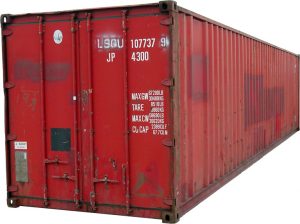How Shipping Containers Were Invented & Shaped International Trade
Guest Post by Ryan Hoek
 The standard shipping container is a widely used medium for loading, unloading and transporting goods from one international port to a distribution center across the ocean. Despite its popularity and large distribution networks through websites like shippingcontainersale.org and shipped.com, rarely do we take the time to learn more about its origin.
The standard shipping container is a widely used medium for loading, unloading and transporting goods from one international port to a distribution center across the ocean. Despite its popularity and large distribution networks through websites like shippingcontainersale.org and shipped.com, rarely do we take the time to learn more about its origin.
For centuries, people have traversed the oceans and seas in search of gold, silver, cotton, food, and other minerals. On other occasions, they have crossed the oceans in order to conquer other kingdoms and loot treasures.
Ever wondered what they used to transport all that loot? Well, they used smaller ships or long boats to transport the goods across the sea. Loading and unloading the ships was a tedious and slow process. In the past, warehouses were unheard of so the goods had to be transported to what was then a port, but essentially it was just a random location on the beach.
This was before the Spanish, Christopher Columbus, Cabot, Vasco Da Gama, and the British set sail to the new world. I am talking about the Greeks, Phoenicians, Vikings, and Egyptians. They were considered to be the earliest sailors after modern scientists found evidence of their voyages across the world. They sailed the oceans and seas to conquer other kingdoms and, afterwards, returned home with treasure and other forms of loots.
To better understand how the shipping container came about, we will begin with the pre-1956 period.
Pre-1956 shipping
As said earlier, the Greeks, Phoenicians, Romans, Egyptians, and Vikings used long boats to traverse the oceans and seas. At first, they used the long boats to discover the rest of the world before they started transporting soldiers with the goal of conquering far off kingdoms.
Back then, other kingdoms had not taken up the art of seafaring, which means ports were nonexistent in certain parts of the world. If there were any, they were only able to handle very small fishing boats, which were not designed to go further into the water. Basically, the boats were used to fish close to the beach.
Fast forward to the 15th century, the world saw the rise of the full rigged ship. This ship was designed with three masts and five to six sails. At the start of the 15th century, Europe and Asia traded via caravan routes over land. Thanks to the development of the full rigged ship, early explorers like Vasco Da Gama, Columbus, and Cabot were able to make their revolutionary journeys around the world.
The emergence of the eastern trade around the 17th century made merchant shipping popular. It all started with the reduction of the crew to a minimum, which helped to improve oceanic navigation. Now that the ships’ design has improved for much longer voyages (from England to China), trade was easy.
At the port, loading and unloading of goods was done in wooden crates, barrels, and sacks. The process was slow and cumbersome. As a result, it came to be known as the break bulk method. This method remained popular for loading and unloading ships until the second half of the 20th century.
Although it was tedious, steps were taken to improve efficiency. They include use of rope to bundle timber, use of sacks to carry coffee, and use of pallets to transport or stack bags and sacks. Due to the rise of the railway system, the inadequacies of the cargo shipping system were highlighted.
Birth of Containerization – 1956 to present
Malcom P. McLean is credited for having invented the concept of containerization. Did you know that he conceived this idea in 1937? Well, at the time he was still running his small trucking company. While watching his trucks being loaded and unloaded, he fumed at the slow pace at which the cargo was being loaded into the ship. Although he conceived the idea of containerization in 1937, it was not until 1956 when he finally actualized the idea.
In 1950, the US Army used a form of “modern standard container” also referred to as the “Transporter” for removal of Korean War supplies. This marked the first use of a modern container for ocean transportation.
In 1951, Western Europe developed container standards for rails which were also intended for use on trucks and ships. This helped to promote international container shipping.
Across the Atlantic, Malcom McLean purchased a railroad terminal and steamship company in 1955 after selling his trucking business for $25 million. He proposed the idea of intermodalism or containerization to Mr. Keith Tantlinger in 1955.
The basic idea was to create a new shipping method capable of holding cargo and also enhance the capacity of the container itself. Mr. Keith Tantlinger developed a locking system which was fitted onto existing cargo storage containers along their edges. In line with the new system, Mr. Tantlinger together with Malcom McLean conceptualized the idea of closing the containers to ensure easy hauling to and from the ship.
After selling his trucking company for $25 million, Malcolm purchased an established shipping company called Pan Atlantic, which was later renamed Sea-Land Shipping, for $7 million. He sought a loan of $42 million to realize his dream of intermodalism.
Apart from the locking system, Keith helped to pioneer the stacking of closed and locked containers, thus introducing large scale cargo shipping. He modified steel containers measuring 40 feet that became the pre-cursors to modern cargo containers.
To test his new idea, Malcom McLean bought an oil tanker — Ideal X — that could hold 58 containers and 15,000 tons of oil. After loading the oil tanker with the new containers, the ship set sail from New Jersey to Houston on April 26th, 1956. Even before the ship arrived at its destination, Malcom Mclean was receiving new orders to transport cargo from Houston to New Jersey.
Further experiments were done on the shipping container, resulting in a super strong, theft resistant, water resistant, and corrosion resistant container that is in use even today. Thanks to his intermodalism idea, Malcom McLean helped in the reduction of shipping costs from $6 per ton to 16 cents per ton. This promoted global trade. Today, the world enjoys the many benefits of containerization.
Author Bio – Ryan Hoek owns and operates a website, shippingcontainersale.org, that helps consumers connect with a shipping container that is perfect for storage or any other use. He is passionate about business, trade, and logistics. In his spare time he likes hunting and reading books.





Nice Blog!! The content you have shared is very elaborative and informative. Thanks a lot for sharing such a great piece of knowledge with us.
Not only was he a genius in developing containers but ran a great trucking company. McLean Trucking. I worked for Smith’s Transfer another great company Jake Smith thought McLean was our strongest competitor. Reo Hatfield Chief Operating Executive Logistics Officer BestTransport